A guide to hybrid event planning and hybrid facilitation

Trainers and facilitators around the world have been experimenting with hybrid event planning in earnest and the results are in: it is possible to facilitate engaging, participatory conversations with groups of people joining in different ways.
This honest* guide to hybrid event planning and hybrid facilitation has all you need to aim for success in this novel environment. Learn how to plan, design and run effective hybrid events with examples from people who have run and participated in this hybrid environment.
This honest guide to hybrid event planning is packed with practical tips, insights and information to get you started setting up, designing and running successful hybrid events. First of all, you’ll find a definition of what hybrid events are, complete with examples of how they may work, hybrid event best practices and more.
Once that is clear, read on to find out three key insights on how to face the challenge of working with both people who share a space and people who join online.
* Why “honest”?
- Because hybrid events can be hard and we’re not going to hide it.
- Because we collected insights based on conversations and experiences from real people, working in the real world.
- And, last but not least, because this guide will not provide cookie-cutter solutions but rather insights, pointers, tips and inspiration – ultimately, as always, the actual design is up to you!
The following sections of this in-depth guide include practical tools, roles that you’ll need to cover, an overview of tech needs, and more. The whole article is packed with useful tips, but if you are in a rush to begin planning, start with this section on practical tools to support inclusion in your next, exciting, adventure in hybrid event planning!
What are hybrid events?
A hybrid event is one in which some participants are sharing a physical space, while others connect online… all at the same time! This is not altogether a novelty. Keynote speakers, for example, were sometimes presenting and answering questions from a screen long before the Covid-19 pandemic came along and hybrid events entered the mainstream.
That said, contemporary hybrid events are going in the direction of more interaction and engagement than a mere Q&A. Effective facilitation is therefore essential to make hybrid participation work.
The word hybrid is borrowed from the natural sciences. In botany and biology, it refers to the offspring of two animals or plants of different subspecies or varieties. A hybrid will preserve some features from each parent and develop others that are completely new. Similarly, hybrid events share some of the characteristics of in-person events and some that come from the online world… and others that are unique.
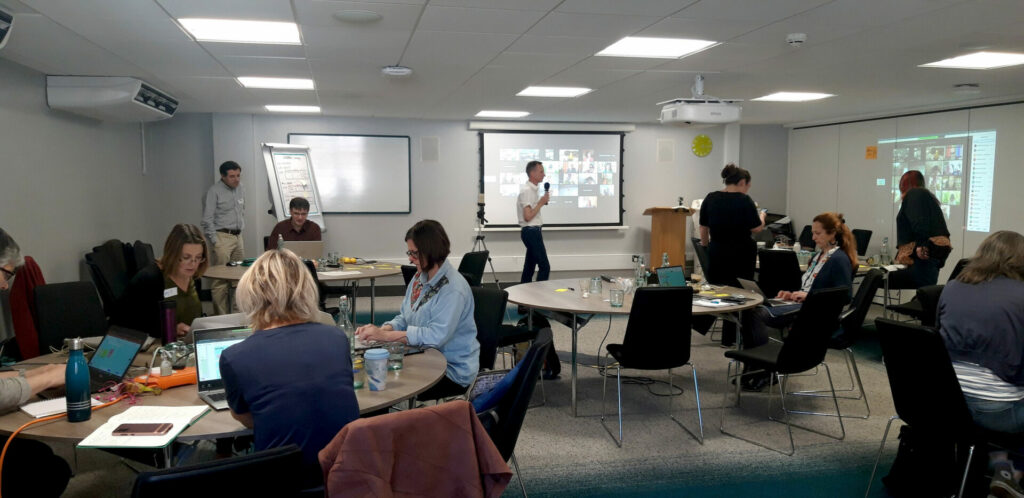
In this guide, we will be using hybrid events, meetings and workshops somewhat interchangeably. Distinctions among them can be made (and are, with great accuracy, by Robert Kienzle in his excellent 132-page Hybrid Live Guide). That said, as long as you aim to facilitate active participation while some participants are sharing a location and others are joining from elsewhere, this guide will apply: take what is appropriate and adapt it to the specifics of your situation.
For more long-term setups in hybrid teams that will work together continuously, this guide will still work for you as facilitator, but you are likely to have to add some research on what workflow and communication tools and apps (such as Slack, Asana and so on, as described in this guide to remote collaboration tools) might support your team in the long term.
Hybrid events are not the only possible way of combining remote and in-person: another possibility is to combine modes of participation not at the same time, but in sequence.
In blended events, sessions are run remotely and in-person at different times, with all participants joining in the same way. Think, for example, of training courses in which everyone meets for intensive seminars, then takes some online modules over the space of a month or two. Here is a little slideshow I put together to illustrate the difference.
Different ways participants may be joining your hybrid event
While all hybrid events have in common the simultaneous presence of participants sharing a physical space and others connecting online, different configurations are possible.
Hub-and-spoke: cohorts of participants who are in the same room, with rooms scattered in different locations, all connecting to the same event. You may have, for example, a group of five joining from the Zurich office, a group of seven in Lisbon, and a larger assembly of twenty joining from headquarters in Copenhagen.

Hub and satellite: one main group joining in person, and individual virtual attendees connecting from their personal devices. This is becoming an increasingly common setup for many hybrid events, e.g. for community/networking gatherings and festivals. The main hybrid event takes place in a physical location, and access is given to remote participants to join with a virtual event platform as well, for the entire event or in part.

A combination of the two is also possible, with some participants joining your hybrid event independently and others in small groups. From the facilitator’s point of view, the scenario changes what activities you can run and how to give instructions for them.
Start your session design process by mapping who will be there, with approximate numbers of participants. Combine this with your overall objectives to create a flow appropriate to the specific hybrid event or meeting.
Why you need to know how to handle hybrid events
In 2020 and 2021, with so many people working from home, facilitators moved their work to online settings. We shared knowledge (e.g. in SessionLab’s remote facilitation guide) the tech improved at breakneck speed, and it’s a safe bet to say that online facilitation is here to stay. Having a virtual event enables wider participation of attendees from different locations and personal situations (or over-booked agendas).
At the same time, in-person events are possible again: those who are able to dedicate the time, and travel, might be keen to attend a physical event. Given all the possible reasons that might keep virtual attendees in front of their screens while others want to be in the same room, it simply makes sense for event organizers to create hybrid event formats.
It is in looking at facilitation practice in 2022 that the striking emergence of hybrids becomes clear, with over 60% of facilitators having led at least a hybrid session (based on the State of Facilitation report).

It’s therefore important for facilitators to be aware of how hybrid events work, and get familiar with how to facilitate them. Just as it was important to learn how to run virtual events alongside traditional in person events during the global pandemic.
Even if you end up deciding that hybrid event planning is not for you, you’ll need to know why, and how to articulate this to clients. Who knows, you might take to this new environment as a fish to (new) waters and become one of the first world-class experts in hybrid facilitation!
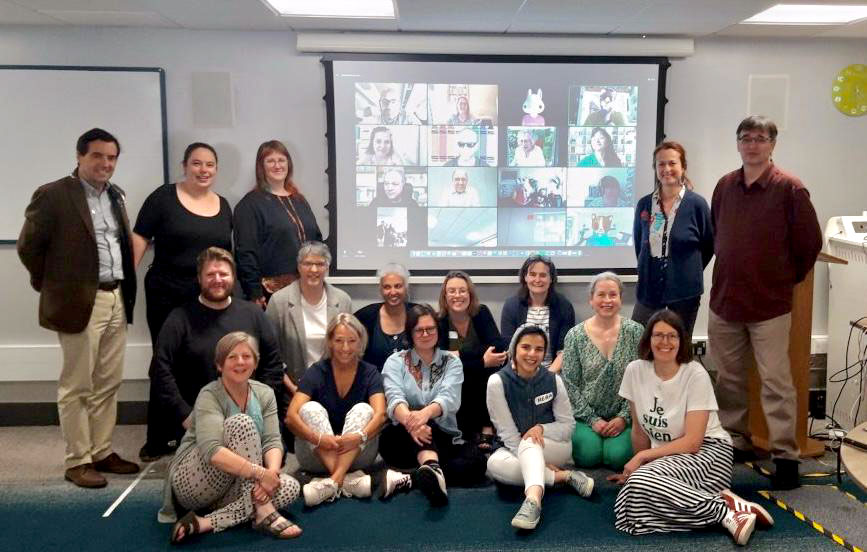
When should you run a hybrid event?
While every facilitator should at least be hybrid-literate, certainly not every event should go hybrid. As hybrid events become increasingly common, it’s important to clearly communicate to clients that they do require more work, (ideally) a larger team, and extra attention to technology. This might mean hiring more people, renting equipment, adding time for preparation and therefore, in essence, more expense.
Hybrid events should not be thrown around as an afterthought or an “add-on” to events planned in a different format. Having a camera pointed at speakers during a conference and allowing people to tune in is not a hybrid event: it’s a live broadcast and/or a webinar. In a hybrid event, we are looking at actual participation of all attendees, in different ways, aiming for the same level of engagement, with a flow of communication among all those involved.
Clearly articulating the specificity of hybrids to event organizers is essential to ensure decisions are taken realistically. Make sure you take the time to ask for the rationale behind the request for a hybrid event.
Discuss pros and cons with the convenor/client. Is is genuinely better than a strictly virtual event? If for the purposes of the gathering it’s a real advantage to allow virtual attendees and in-person attendees, and the resources to make this happen are available, then go for it!
What are the challenges of hybrid event planning?
In terms of facilitation, all hybrid events require three complete designs: one for the people who are sharing the room, one for those joining remotely, and one for the connection between the two.
The novelty of this scenario and the complexity of juggling so many moving pieces made handling hybrids one of facilitators’ main challenges in 2022, according to the State of Facilitation report!

It can get even more complicated in cases in which you will have to tweak instructions for different numbers of people joining from different rooms: in the “hub-and-spoke” model, for example, activities might need specific instructions if some groups are even and some odd-numbered!
Besides the challenge of running different programs simultaneously, hybrid events add the hurdle of combining them. If this effort fails, you are likely to end up with disengaged participants or groups. This can create disagreements and conflict between your virtual audience and in-person attendees. People may end up feeling slighted or excluded from certain conversations, dynamics or decision-making taking part in other parts of your hybrid event.
Ideally, participants joining in different ways should still have many opportunities to work together and interact, create bonds and foster the sense of being “in this together” as parts of a whole.
Taking into consideration people with disabilities and neurodivergent people will require additional hybrid event planning. You’ll need to consider how to support access to audiovisual technologies and resources these people may need to participate fully in your hybrid events. Just as accessibility should be considered for any in person event, the same is true for virtual attendees and their hybrid counterparts.
How to plan a successful hybrid event
In early 2022, the Italian chapter of the International Association of Facilitators hosted a one-and-a-half-hour discussion among a group of about 30 professional facilitators on the topic of hybrid events. At the end of the conversation, three approaches emerged as crucial for facing the hybrid challenge successfully and making hybrid event planning more effective:
- Keep it simple
Keep. It. Simple. These were the three most-oft-repeated words at the workshop! The setting of a hybrid event is so complicated that simple activities work best. Keep the instructions clear and minimal and be a bit more directive than you normally would. This advice was valid when moving towards virtual events and its valid here too!
Don’t worry about being too basic or linear: trust that the nature of hybrid events will provide added complexity, and throw you some curveballs. That is when you will be grateful for all the head-space you will have given yourself by rejecting more elaborate methods or activities.
- Craft a spacious design
Make sure you have defined objectives with the event organizers, and plan activities to ensure those are reached. Because there are so many uncertainties connected to the technology and all the different settings, keep the breaks as actual breaks rather than scheduling leisure activities or games.
Virtual attendees will need that time to get away from the screens. Those people who are physically present will be glad to have informal opportunities to mingle and relax. And you and your team will need all the time you can get to make last-minute adjustments or, if you are lucky, take an actual break! Approach your hybrid event planning with spaciousness and generous time buffers in mind for best results!
- Gather feedback and correct course
Another piece of advice that is always valid, but worth focussing on for hybrid events: gather feedback, iterate and correct course. Hybrid event planning requires a lot of preparation, but this should not mean you are now bound to a definitive schedule that will never change.
Every group and interaction is different. Learning how to ensure your specific hybrid event is successful will require adaptation to the unique context at hand. What works for a virtual audience is different for those at the in-person event, and so too might it be different during a hybrid event. As such, it pays to listen and create space for feedback.

Involve participants from the beginning in shaping your hybrid strategies (see below for more on how to do this) and schedule regular moments for feedback. For longer events, this could be at the end of each day. For shorter workshops, don’t wait for the last moment: ask for feedback about mid-way, ideally just before a break, so you can start making some changes right afterward.
Time for feedback on the process should not take long: use a poll and get some insight in 5 minutes.
You might want to ask questions such as:
- Which cohort are you in (online, in-person…)? [multiple choice]
- How connected do you feel to your cohort (the other people participating in the same mode as you)? [quantitative, e.g. on a scale 1-5]
- How connected/aligned do you feel with respect to the other cohort(s)?
- How easy/hard is it for you to contribute to discussions?
- What are the facilitators doing that is working well to make this hybrid event a success? [open question]
- What could we do to make the experience even better?
Collecting feedback in this way is serving more functions than one. First of all, you are gathering information that can help you and your facilitation team improve as the event goes on, shaping it based on your specific group’s needs. Secondly, you are modeling flexibility and willingness to adapt and change, two values that are likely needed in any organization or group you might be working with, all the more so if they are experimenting with virtual and hybrid events.
At the same time, you are raising the participants’ awareness of the process, even just by the simple act of reminding them that different cohorts in your hybrid event might have different needs and experiences. This in itself makes it more likely for attendees to collaborate in making it easier for everyone to be included and contribute.
Remember that this feedback is invaluable for future events. Be sure to share this with the hybrid event organizer, the rest of the team and potentially the attendees too!
Hybrid events best practices
In this section we will cover a range of practicalities you’ll need to keep in mind while designing, setting up and running hybrid events. The first part is a deep dive into strategies to support inclusion of different groups. This is arguably the number one challenge of a hybrid event: in this section, we find out why, and list some strategies as well as four practical tools you can use to make sure inclusion is fully supported, wherever your participants may be!
Next, we touch upon the intricacies of tech setups. As virtual event platforms and tech solutions change all the time, so rather than recommend specific solutions, we will be pointing out what you need to watch out for and keep in mind during hybrid event planning and when facilitating a successful hybrid event.
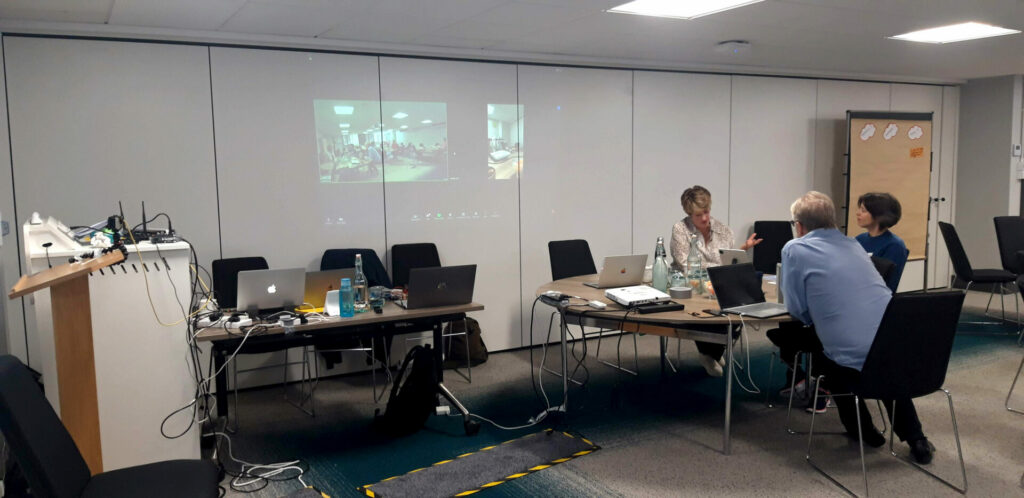
The third essential matter to consider is your prep work: besides designing carefully and mapping participants, you’ll need to figure out how you will communicate instructions in different ways to both virtual and in-person attendees.
As facilitators, we are already wearing various hats, and hybrid event planning and facilitation will add some new ones to your collection. In this section, we use roles as a way of framing how to best set up a hosting team, and who will do what.
The fifth and final matter to consider is how to run different types of activities: plenaries, small-group, individual, as well as specific activities, to bridge the different cohorts. This section is packed with practical tips to get every part of your program fine-tuned and hybrid-proof!
Ready to dive in and learn what it takes to run a successful hybrid event? Let’s start by looking at thorny matters of power dynamics and how to bridge those differences.
How will you make sure everyone is included in the hybrid conversation?
In any gathering of human beings, there is bound to be a lot of diversity, and some imbalance of power. This is the case for in-person events and it remains true for hybrid events too.
As facilitator, part of your role is to make the invisible dynamics intelligible to all participants. Offering new vocabulary and words to express what is going on in terms of power dynamics allows the group to reframe them as cultural artifacts: elements that can be interacted with, evaluated and, if needed, changed.
Let’s consider some key points concerning possible power imbalances specific to the hybrid environment, and what we, as facilitators, can do about them.
Power imbalances in hybrid events
Here are three typical cases of how the hybrid setting can exacerbate pre-existing power imbalances or create new ones. The next time you join or lead a hybrid event, see if you can spot these as they happen!
- In-person attendees may have a stronger say – Participants who meet in person will have all the benefits of sharing space and are likely to tend to create a niche culture for themselves, based on the simple fact that they will read one another’s body language and subtle cues. As facilitators, we should raise each group’s awareness of cohorts joining from other locations and not fall into the trap of allowing the in-person group to prevail over virtual attendees.
- The largest group, wherever it is, may dominate – There certainly is power in numbers, and the largest group of attendees, whatever their position, may hold greater sway over the entire hybrid event. Pay extra attention to the minority and make sure those voices are heard, perhaps by inviting them in, as you would with any quiet participant (“We haven’t heard from the folks over in Sydney in a while.. I’d like to just check in if there is anything you’d like to add…?”).
- Those who share the facilitator’s position might prevail – By the mere, inescapable fact of being humans, facilitators may develop an unconscious bias towards the people in our same room or position, creating momentary alliances. Be aware of the “us vs. them” risk. You may find it natural to prioritize those with whom you are sharing space, or a situation (e.g. if the facilitator is online), and should remind yourself to check your biases and act accordingly for all hybrid events.

How to handle power imbalances
Our goal as facilitators is to make sure everyone’s voice can be heard. There are (at least) two pathways to getting there. The first is to work on your awareness as a facilitator, while the second leverages the collaboration of the entire group.
- Keep power imbalances in your awareness and be attentive to them.
Consider this part of your facilitation prep work. Take time to consider where power imbalances might be and how your own stance, language and behavior can worsen or improve the situation.
If you know you will tend to prioritize in-person participants (because you are in the room with them, or out of pre-virtual-facilitation habit learned from attending online events), make a mental note of this. Remind yourself and your team to take questions from online participants first. Place the screen on which you see the online participants where your attention will be directed to it.
If you catch yourself internally agreeing with the in-person attendees more than with the online ones, ask yourself why. Are you fully understanding them, or are you missing their point (perhaps because of the lack of visual clues)? If you’ve run a lot of virtual events, that experience will help here too!
- Focus all participants’ attention on the hybrid scenario, open a conversation and co-create support systems.
If you got the impression that the previous point might leave you exhausted, you are probably right. Holding your attention on the in-person and online groups at the same time is yet one more task for your already pretty busy inner juggler.
What can you do? Use one of the tools facilitators like best: throw the ball right back to your participants! Take time at the beginning of the session to discuss with the group: how are you feeling about being in this hybrid event? What examples of successful hybrid collaboration have you experienced? What would help you participate fully, at your best?
This can be part of the slot you have set aside to present and discuss ground rules/group agreements, or can be a specific conversation. With a large group that will meet only once, for example for a community event, it may be enough to acknowledge the challenge out loud, and propose some basic agreements.
With groups that will work together longer, e.g. in a series of workshops or a company team, it’s definitely worth spending time talking this through together.
At the start of a workshop, kick-start separate conversations in the different groups around such questions as:
- How does it feel to be in this cohort?
- What do you think might be obstacles to your full participation in the event today?
- What would work for you to counteract these? Do you have any requests for the plenary group?
- How do you imagine the other group(s) feel about this setting? What might support them?
Then, use the What I need from you activity from Liberating Structures to facilitate a dialogue among the different groups of participants and invite them to ask of each other what they need to support full participation.
This process can feed into drafting your group’s unique “hybrid event collaboration agreement”, which you can revise as you go.
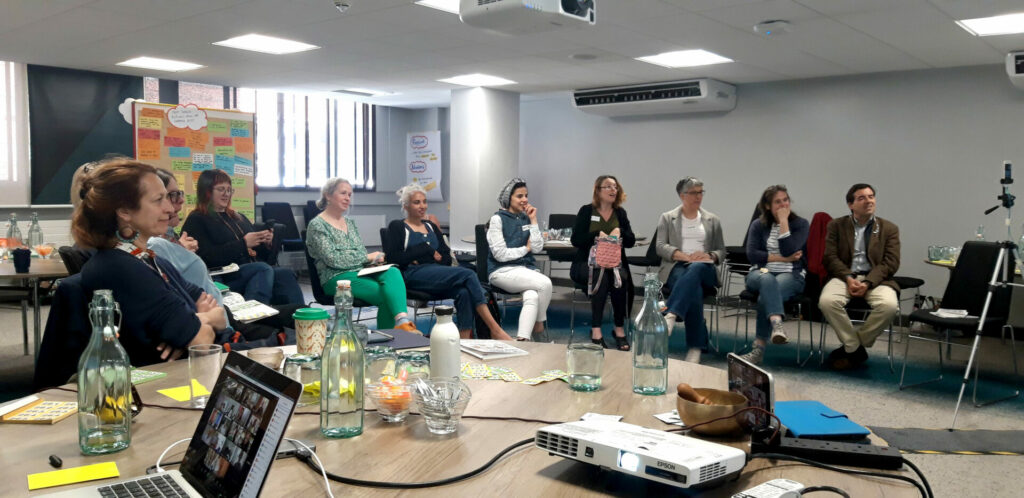
Practical tools to support inclusion
Map the group
For participants – Use maps and diagrams to make sure everyone knows who is in the hybrid event, whether or not they are in the room. If people are joining in a huddle from the same screen, ask them to add individual names as well as the location (e.g. “Marina, Hannah, John – Vienna team” rather than just “Vienna team” or “Marina”). Names of participants joining remotely might be hard to read if they are projected on a screen for the in-person crew: make a map of your hybrid event participants on a whiteboard so everyone can see who they are interacting with.
For yourself – Draw a diagram, for your own use, of who is where. Keep it on top of your notes. Add a mark next to the name of those who are taking the floor and speaking up. Even if you don’t remember to do this every time, you might still notice patterns emerge. Are people in the physical space, or in one particular room, participating more? What about your virtual audience? Try some nudging to rebalance this, e.g. by inviting a specific group to speak up more “I’d love to hear what our colleagues in Paris think about this…”
Language matters
Take a moment before the event to decide on how you will refer to the different groups in your hybrid event, and stick to it. This can also be part of the explicit agreement you establish with participants. Avoid creating accidental hierarchies in your virtual and hybrid events by referring to one situation as not-that: in-person and not-in-person, on-line and off-line or, worse, “here” and “there”.
Several facilitators and educators have been popularizing the idea of talking about roomies and Zoomies (I first heard of this trend from Judy Rees over at ReesMcCann). While this may not apply to your situation (you may be using another software, or have more than two groups) it’s a great example of what works. The two terms are fun, playful, and neutral, in that they do not imply one is more important or better than the other.
Hybrid buddies
What do you do when you have a large group of people traversing an unfamiliar landscape, like a big city, and you want to make sure nobody gets lost? You create a buddy system! As we set out with our group to explore the terrain of our hybrid event, we can do the same. At the start of the workshop plan team-building activities in breakout rooms (see here for our handy methods list) to form a buddy pair, triad or huddle.
Inform participants that this group will remain stable throughout the event and be the setting in which they can support one another and draw the best from the different situations they are in. People connecting from their computers are at an advantage in terms of doing quick research. Those sharing a room with a facilitator might find it easier to attract your attention, or to speak out.
A buddy system is an excellent solution to ensure the group shares the challenge of making this the best possible hybrid experience, and lighten your load as well!
Use polls for convergence
When taking decisions or checking the room for agreement, there is a heightened risk that people will stay silent in a hybrid event. Because facilitators will be dividing their attention among different cohorts, it is easier to miss subtle body signals or facial expressions. Make moving towards convergence easier by using polls like those you would use in a virtual event to make sure everyone has an opportunity to pitch in a vote or a comment.
Participants at in-person events can use their mobile phones to take part in online polling apps like Menti and Slido (find more ideas on what tools to use in this article on tools for remote participation). By checking the number of people contributing to a poll, you can instantly verify participant engagement, count votes and move the group towards decision-making.
What technology should you consider when planning a hybrid event?
The tech side of planning a hybrid event can be daunting. There are a lot of choices to make that need to take into account the logistics of both in-person events and virtual events. There’s also some cool new tech (such as Owls, cameras designed to follow the speaker) to consider, but ultimately it comes down to figuring out, based on the constraints of the specific situation, how to enable everyone to hear and see one another, in all possible directions.
How will participants at your in person events be able to see those online? Screens and projectors will need setting up. How will remote attendees see those in person? At the very least, you will need multiple webcams pointed on the facilitator/speaker, the other participants, and any materials (e.g. whiteboard).

In hybrid events, sound is even more important than sight to allow for interaction and participation. Be aware that people might even be joining from their phones, with audio-only, if the connection does not allow for more data sharing.
What exactly to do in order to allow everyone to hear one another depends on the situation, but for sure you will need ways for people connecting online to clearly hear participants in the room, and vice-versa. You might have the option of using a multi-directional mike, or require an assistant with a cordless microphone to move around the space.
Having an established spot with a microphone from which online attendees can clearly hear the speaker is the easiest tech setup. This will probably translate into having to remind participants of where to go when they want to speak, until a routine is established.
Small group work mixing online and remote participants is the hardest type of activity to set up if your location has limited space: if everyone is working together, with both in-person and virtual audience, there will be a lot of audio interference from hearing different voices and echoes coming from many speakers.
Be aware of the limitations beforehand, and plan activities based on the constraints of the specific location. Make ample time in your schedule for planning and checking your tech, just as you would for a virtual event.
It’s also important to have a backup plan to communicate with cohorts that are not sharing the space with you in case something fails (e.g. by setting up an instant messaging channel for all hybrid event attendees – and another one for just the hosting team!).
Virtual online whiteboards and shared documents, giving the possibility to all participants to visualize the same information and capture insights directly, are a great support to keep everyone aligned and on track. These work just as well in hybrid as they do in a virtual event. Define a single source of truth for your hybrid events where attendees can find all the key information on the program, links, contacts and schedule.
The hybrid event format allows virtual and in-person attendees to create particularly rich shared documentation by working together. Set up shared documents and galleries on which to upload pictures and output from exercises.
In this facilitation story by Daniel Unsöld, the shared whiteboard used during a multi-day hybrid event functioned as a home base to orient remote participants who dropped out and reconnected, something which is likely to happen with longer gatherings.
How to prepare for your hybrid event?
The factors limiting your design choices will fall into three categories: distribution (of participants), objectives (co-defined with your client/host) and technology (in which we are including also factors connected to the location). Before starting to create a session flow, define your objectives clearly.
Design based on desired outcomes; especially if these are your first experiments with hybrid events, trim down activities you may be tempted to insert as extra bits but that do not serve the main purpose.
Next, map all the participants of your hybrid event. Even if the map is approximate, it will still help you clarify what is needed for the different cohorts. Think about the technology available and any limitations connected to available spaces (e.g. acoustics). Remember that many of the logistic concerns of an in-person event (accessibility, room size, etc.) still apply!
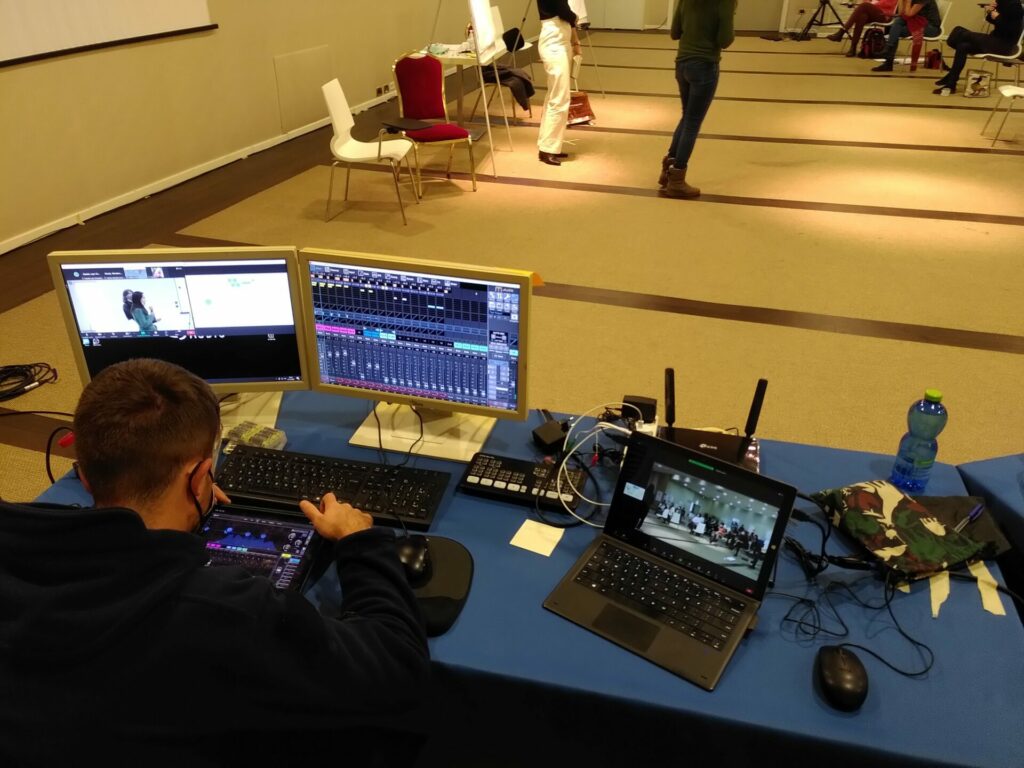
Similarly to virtual events, and more so, hybrids require a lot of preparation. Get instructions ready for every activity. Virtual attendees will benefit from having instructions written up for them, perhaps in a slide or ready for the tech host to drop in the chatbox. Printed or projected instructions can also help participants who attend in person to understand the activity better, particularly if you expect your attention to be going to the remote cohort at that time.
What roles need to be covered for successful hybrid events?
What follows is a list of roles, not of people. A role is a part played by someone in a particular situation. For example, you are probably familiar with the role of time-keeper. You may keep the role of time-keeper for yourself as facilitator, or you may delegate it to a co-host, or even appoint a participant to remind everyone of the time. You may even use an app or automatic reminder to cover the role.
Roles are a useful lens through which to puzzle out the problem of creating the best team for a successful event: a person might fill more than one role, and a role could be filled by more than one person.
In any hybrid event, you need to consider all the roles you would for an in-person event, plus the ones needed to successfully run an online gathering, and a couple of new ones. Depending on the exact nature of your hybrid event, event organizers, number of participants, type of setting and so on, you may need to cover many different roles yourself, or have a hosting team.

There is no point in trying to be a jack-of-all-trades if that is going to be exhausting and result in less attention given to participants. Go through this list whilst planning your hybrid events and make sure you know how many roles you are taking on, whether you have enough resources to delegate the roles you need other people to do, or if you need to onboard apprentices, volunteers, (or even participants!) to cover some of these.
Event designer
This is a role you are likely to be taking yourself, perhaps alongside someone from the convening team (aka, probably, your client). At the design stage, consider what the experience will be like for all the different groups involved in your hybrid event, create your plans B (and C…D?). Take a look at this template to see how the breakout session function of SessionLab can help you organize your design for a hybrid event.
Lead facilitator
This is the role mainly responsible for guiding participants through the various activities of your hybrid event. The lead facilitator’s main focus is on awareness, clarity and inclusion. As lead, you’ll need to have the mental space required to sense the room and be as present as possible with the participants, regardless of which cohort they are in.
There is no firm rule or established practice in hybrid events as to where the lead facilitator is. The default may be to attend in person events, but it’s worth considering based on your specific event. They may be with the largest group meeting in person, with one of the satellite groups, or working alongside virtual attendees. This will influence power dynamics and tech needs.
Tech host/producer
The tech hosting role is the one ensuring that the online environment works as smoothly as possible. This role is usually behind-the-scenes and is often (but not necessarily) silent. Think of who will be answering people in the chat, setting up breakout rooms and giving everyone access to links for whiteboards and polls. Anyone used to running a virtual event will find their skills useful here.This person may also be responsible for choosing a hybrid event platform or which online tools you will use.
Video/audio specialist
The technological aspect of hybrid events is key to enabling full participation. Video is important, and audio is fundamental! This role is there to ensure participants can see and be seen, hear and be heard. Experience in running virtual events and using those tools will be invaluable here.
Visuals curator/designer
Well-crafted visuals can be a great support for different groups to participate and follow. The role of the visuals curator/designer is to support full engagement with the aid of graphic tools. This might coincide with the work of a graphic recorder and/or might be more focused on preparing virtual whiteboards, curating collections of snapshots from the various locations, and so on.
Bridge-builder
This role’s task is to pay particular attention to the connection between the different cohorts throughout your hybrid events. It may be partially filled by elements of the design itself, or there might be a person tasked with putting extra attention to this element. Though this might seem like an optional role, the bridge-builder can be vital in creating a successful hybrid event.
Time-keeper
A time-keeping role is essential for every meeting, hybrid or not. That said, because different groups at your hybrid events will be in such different settings and probably, at least part of the time, doing different activities, a time-keeping role is essential to ensure everyone stays on track.
What should you keep in mind when designing and running activities at a hybrid event?
Facilitators love to mix and match different types of activities to create an engaging flow. Below, you’ll find some practical tips on how to adapt different types of activities for a hybrid event, including plenary sessions, small-group work, individual work and a special new extra hybrid-only category: activities bridging the virtual and in-person worlds.
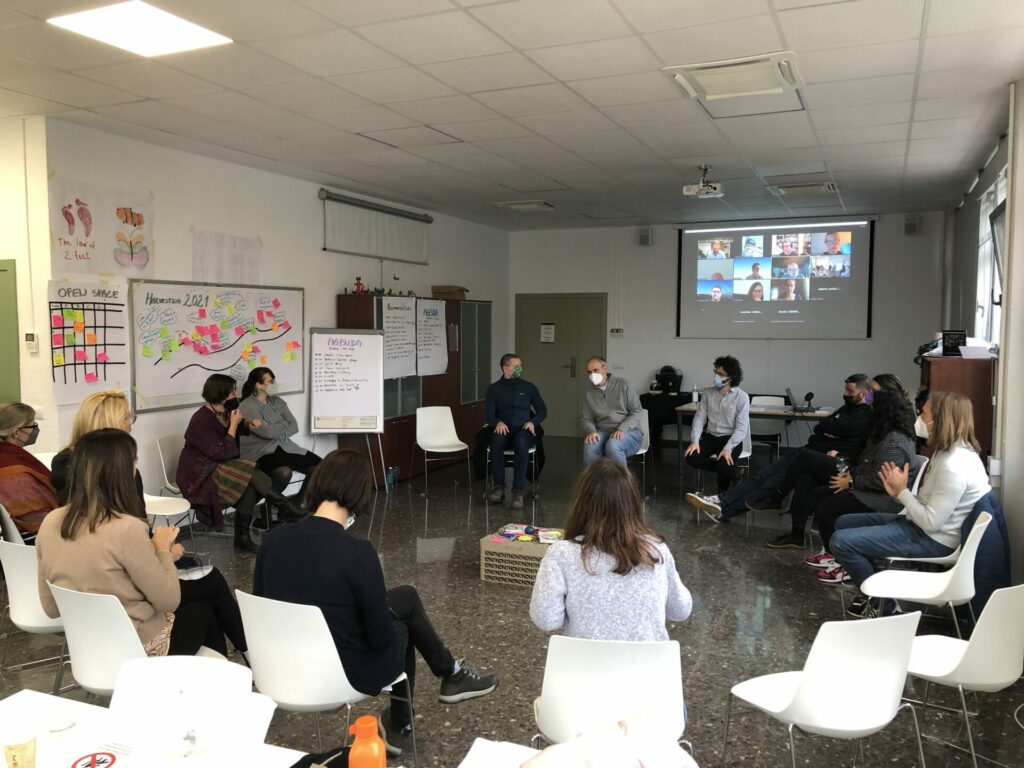
In plenary
When everyone is working together at the same time, the challenge is holding everyone’s attention and keeping the event cohesive. Excellent audio and video are key here, as you want to make sure participants and speakers can see and, even more importantly, hear one another wherever they are.
Tips for facilitating plenary sessions in hybrid mode:
- Ensure your audio and video setup allows speakers to be heard and seen by all;
- Keep presentations short and interactive, use polls to punctuate longer talks;
- In Q&A sessions, give the floor first to the group that is at a disadvantage in that setting (in many cases this means the online cohort, but other scenarios are possible, e.g. the speaker and facilitator are both online and there is a small group meeting in person, in which case, prioritize them!);
- Make sure discussions are captured in a way that is accessible to all. If you have someone writing on a physical whiteboard, take pictures and upload them on a virtual platform, so your virtual audience can see what was written down and so that attendees to your hybrid events can review later.
Small group activities
Facilitators appreciate the benefits of working in small groups and breakout sessions, where participation is higher and everyone has time to get their say. This remains valid in hybrid events. Here are some specific considerations to keep in mind.
There are basically two ways of organizing small group work in a hybrid event. If your tech setup allows it, you should consider alternating both of these in your design, as they have different benefits.
- Different activities for online and in-person participants.
Beginning with the same objective, design different things to do for the people who are sharing a space and for those who are online. This will allow you to benefit from the best of both worlds throughout your hybrid event. In-person groups can move around and use objects, maybe do a role play. With virtual attendees, you can encourage using the power of quick research and note-taking.
An example of this would be a storytelling activity in which the people who are in the same room tell a story with objects and acting, while the ones who are online create a storyboard using images collected from the web.
If you need to give different instructions to the two groups, make this clear, and share in a slide or chat the instructions for your virtual participants. If timings are different, give the remote crew more breaks, as they are needed to counteract the fatigue of being online.
- Mixing online and in-person participants in small groups.
This is the kind of activity that will feel most unique to hybrid events. To enable participants in different settings to work together, each small group will need their device (laptop or phone). You can leverage the fact that both the in person and virtual audience of your hybrid events will likely have a smartphone in their pockets.
The two limiting factors in this event format are bandwidth and acoustics. Firstly, you need to make sure the connection at your location can be trusted with multiple people connecting at the same time.
Next, try to imagine what the space will sound like with numerous conversations going on in hybrid mode: will participants be able to hear voices coming from different audio equipment? The risk is that everyone in the hybrid event will raise their voices and create a distracting cacophony. This can be avoided if the space allows participants to wander into different breakout spaces or use the outdoors.
Tips for facilitating small groups at a hybrid event:
- Include in your design activities in which each cohort works separately and others in which they work together (as long as this is feasible for your tech setup);
- Keep instructions as clear and simple as possible.
- Get everyone together again to debrief and share reflections;
- Use shared documents online to capture learnings.

Individual activities
Make space for individual reflections as well as group work during your hybrid event. Before a brainstorming session, or at the end of a block of activities, learning is enhanced by having a quiet moment for each person to answer prompt questions individually. If you need to create breakout groups online or do other behind-the-scenes work, you will thank yourself for putting some time for participants to do individual work just before the activities you need to do more setting up for.
Bridging the online and in-person groups
In a hybrid community gathering held in December 2022 in Valencia, which was based on this template, the facilitation team was looking for a simple way to connect people joining online to those in person on a very human level.
With co-facilitators Rowan Simonsen and Szilvia Zsargo, we decided to punctuate the event with what we called hybrid checkpoints: every two or three hours during our hybrid event, me and Szilvia invited the in-person audience in Valencia to scatter in the outdoor space of the campus and use their phones to connect to the Zoom call their colleagues were on.
Once they were in the call, Rowan, who was hosting the virtual component, created pairs (in some cases, triads) and sent them off for a 10-minute chat in breakout rooms. The prompt was simply “how are you doing and what are your insights at this point in the gathering?”. The insights collected were invaluable, and both virtual and in person attendees reported feeling a real sense of connection and empathy.
Hybrid events checklist
We hope this guide gives you all your need to feel prepared and confident in setting up a successful hybrid event.
And since there is a lot in here, we thought it might be helpful to add a checklist you can go through while planning and designing. Whether you’ve never run an in-person event or or a pro, hybrid events have many moving parts and this guide can help you ensure a smooth process.

In closing… let’s learn together, fast!
Have you thought of how and where you will share your learnings about hybrid events and meetings?
Tools and skills around hybrid events are likely to be the defining topic for the next few years, and this is just the beginning. After all, it’s one of the best things about working in facilitation: the learning never stops!
We can all expect a lot of new things to learn, success stories (and the occasional spectacular failure) from the world of virtual events and hybrids. Learning is faster and more effective when we learn together as a global community of practice, so consider contributing by sharing your stories and experiences of hybrid events with other facilitators, including in comments to this piece!
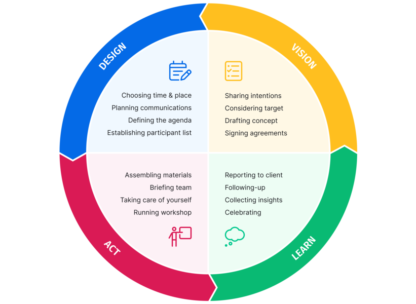
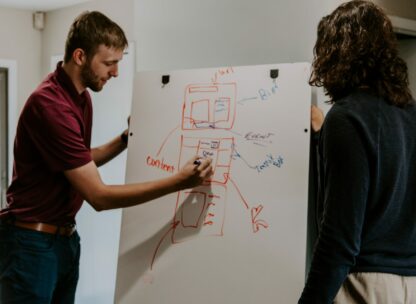

Leave a Comment